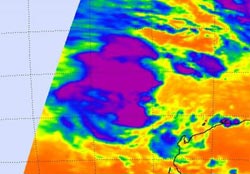NASA infrared satellite data gives System 96S a fair shot at becoming a tropical cyclone

A NASA AIRS instrument infrared image captured on Feb. 9 at 17:47 UTC (12:47 p.m. EST) showed some strong convection and strong thunderstorms (purple) with very cold cloud-top temperatures, around the center of System 96S. Credit: NASA/JPL, Ed Olsen<br>
When Aqua passed over System 96S on Feb. 9 at 17:47 UTC (12:47 p.m. EST), the Atmospheric Infrared Sounder (AIRS) instrument showed some strong convection and strong thunderstorms with very cold cloud-top temperatures around the center of circulation.
Those cloud top temperatures were as cold as or colder than -63 Fahrenheit/-52 Celsius indicating strong convection, strong thunderstorms, and heavy rainfall. The imagery suggests that the convection is consolidating and increasing around the low's center.
Convection is limited on the eastern half of System 96S because of moderate vertical wind shear (winds that can weaken a storm) blowing near 30 knots (34 mph/55 kmh)! That wind shear, however, is expected to weaken and enable the low to strengthen. Another factor that will help System 96S strengthen is the warm sea surface temperatures that it's located in. Sea surface temperatures are estimated near 30 degrees Celsius (86 Fahrenheit). Tropical Cyclones need sea surface temperatures of at least 26.6 Celsius (80 Fahrenheit) to maintain strength or intensify.
At 2300 UTC on Feb. 9, (6 p.m. EST) System 96S had maximum sustained surface winds near 20 to 25 knots (23 mph/ 37 kmh to 29 mph/46 kmh). It was located about 260 miles (418 km) northwest of Barrow Island, Australia near 17.7 South and 112.2 East. Residents of Western Australia are keeping a close eye on this system for development.
Media Contact
More Information:
http://www.nasa.govAll latest news from the category: Earth Sciences
Earth Sciences (also referred to as Geosciences), which deals with basic issues surrounding our planet, plays a vital role in the area of energy and raw materials supply.
Earth Sciences comprises subjects such as geology, geography, geological informatics, paleontology, mineralogy, petrography, crystallography, geophysics, geodesy, glaciology, cartography, photogrammetry, meteorology and seismology, early-warning systems, earthquake research and polar research.
Newest articles

A universal framework for spatial biology
SpatialData is a freely accessible tool to unify and integrate data from different omics technologies accounting for spatial information, which can provide holistic insights into health and disease. Biological processes…

How complex biological processes arise
A $20 million grant from the U.S. National Science Foundation (NSF) will support the establishment and operation of the National Synthesis Center for Emergence in the Molecular and Cellular Sciences (NCEMS) at…

Airborne single-photon lidar system achieves high-resolution 3D imaging
Compact, low-power system opens doors for photon-efficient drone and satellite-based environmental monitoring and mapping. Researchers have developed a compact and lightweight single-photon airborne lidar system that can acquire high-resolution 3D…





















